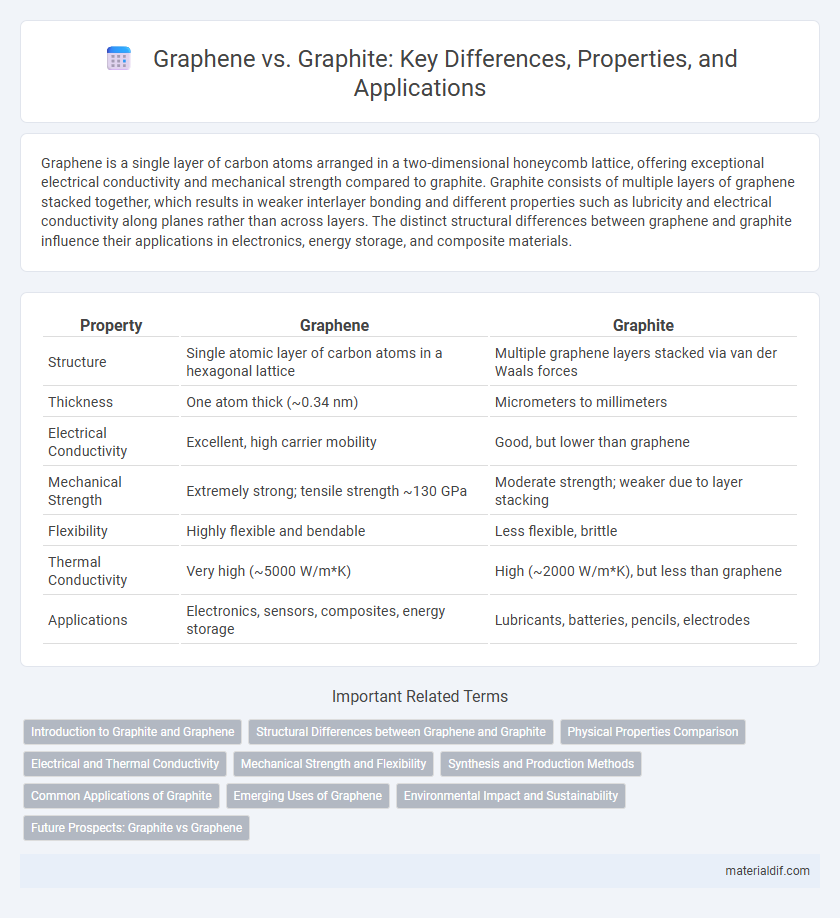Graphene is a single layer of carbon atoms arranged in a two-dimensional honeycomb lattice, offering exceptional electrical conductivity and mechanical strength compared to graphite. Graphite consists of multiple layers of graphene stacked together, which results in weaker interlayer bonding and different properties such as lubricity and electrical conductivity along planes rather than across layers. The distinct structural differences between graphene and graphite influence their applications in electronics, energy storage, and composite materials.
Table of Comparison
| Property | Graphene | Graphite |
|---|---|---|
| Structure | Single atomic layer of carbon atoms in a hexagonal lattice | Multiple graphene layers stacked via van der Waals forces |
| Thickness | One atom thick (~0.34 nm) | Micrometers to millimeters |
| Electrical Conductivity | Excellent, high carrier mobility | Good, but lower than graphene |
| Mechanical Strength | Extremely strong; tensile strength ~130 GPa | Moderate strength; weaker due to layer stacking |
| Flexibility | Highly flexible and bendable | Less flexible, brittle |
| Thermal Conductivity | Very high (~5000 W/m*K) | High (~2000 W/m*K), but less than graphene |
| Applications | Electronics, sensors, composites, energy storage | Lubricants, batteries, pencils, electrodes |
Introduction to Graphite and Graphene
Graphite consists of multiple layers of carbon atoms arranged in a hexagonal lattice, providing excellent electrical conductivity and lubrication properties. Graphene is a single atomic layer extracted from graphite, demonstrating exceptional strength, transparency, and superior electrical and thermal conductivity compared to bulk graphite. The unique two-dimensional structure of graphene enables revolutionary applications in electronics, energy storage, and composite materials, contrasting with graphite's traditional uses in pencils and lubricants.
Structural Differences between Graphene and Graphite
Graphene consists of a single layer of carbon atoms arranged in a two-dimensional honeycomb lattice, whereas graphite is composed of multiple graphene layers stacked in a three-dimensional structure held together by weak van der Waals forces. The sp2 hybridization in both materials gives them strong covalent bonds within layers, but the interlayer bonding in graphite allows for easy shear and lubrication properties absent in monolayer graphene. These structural differences result in varying electrical, thermal, and mechanical behaviors, with graphene exhibiting exceptional conductivity and strength at the atomic scale compared to bulk graphite.
Physical Properties Comparison
Graphene exhibits exceptional physical properties compared to graphite, including a tensile strength of approximately 130 GPa, far surpassing graphite's strength. Its electrical conductivity reaches up to 6000 S/cm, while graphite, composed of stacked graphene layers, shows much lower conductivity due to interlayer resistance. Graphene's flexibility and transparency contrast with the brittle, opaque nature of bulk graphite.
Electrical and Thermal Conductivity
Graphene exhibits superior electrical conductivity compared to graphite due to its two-dimensional structure, allowing electrons to move with minimal resistance. Thermal conductivity in graphene is exceptionally high, surpassing graphite as its single atomic layer enables efficient heat dissipation. Graphite's layered structure results in anisotropic properties, causing lower conductivity rates in the direction perpendicular to the layers compared to graphene's uniform conductivity.
Mechanical Strength and Flexibility
Graphene exhibits exceptional mechanical strength, with a tensile strength of approximately 130 GPa, making it one of the strongest known materials, while graphite's strength is significantly lower due to its layered structure held together by weaker van der Waals forces. Graphene's single-atom thickness and two-dimensional structure provide remarkable flexibility and elasticity, enabling it to bend without breaking. In contrast, graphite's bulk form is brittle and lacks the flexibility seen in graphene sheets.
Synthesis and Production Methods
Graphene, a single layer of carbon atoms arranged in a hexagonal lattice, is primarily synthesized using methods such as chemical vapor deposition (CVD), mechanical exfoliation, and chemical reduction of graphene oxide. Graphite consists of multiple layers of graphene stacked through van der Waals forces and is typically produced via high-temperature treatments of carbonaceous materials or naturally mined. While graphite's bulk production is well-established, scalable and controlled synthesis of high-quality graphene remains a focus of advanced research and industrial development.
Common Applications of Graphite
Graphite is widely used in applications such as lubricants, pencils, refractory materials, and batteries due to its layered structure and excellent electrical conductivity. Graphene, a single layer of carbon atoms extracted from graphite, is primarily utilized in advanced electronics, sensors, and composite materials for its exceptional strength and conductivity. Despite the growing interest in graphene, graphite remains essential in traditional industries because of its cost-effectiveness and well-established manufacturing processes.
Emerging Uses of Graphene
Graphene, a single layer of carbon atoms arranged in a hexagonal lattice, exhibits extraordinary electrical conductivity, mechanical strength, and flexibility, setting it apart from its bulk counterpart, graphite. This groundbreaking material is revolutionizing industries with emerging uses in flexible electronics, advanced energy storage devices, and high-performance sensors. Ongoing research explores graphene's potential in biomedicine and environmental technology, highlighting its transformative impact beyond traditional graphite applications.
Environmental Impact and Sustainability
Graphene's production requires fewer raw materials and generates less waste compared to traditional graphite mining, making it a more sustainable option for advanced materials. The extraction of graphite often results in soil degradation and water contamination, whereas graphene can be synthesized using greener methods like chemical vapor deposition or exfoliation from recycled graphite. Due to its exceptional strength and conductivity, graphene enables the development of eco-friendly technologies such as efficient batteries and lightweight composites, further reducing the environmental footprint.
Future Prospects: Graphite vs Graphene
Graphene, a single layer of carbon atoms arranged in a hexagonal lattice, exhibits exceptional electrical, thermal, and mechanical properties, positioning it as a revolutionary material for future technologies like flexible electronics, energy storage, and nanocomposites. In contrast, graphite, composed of multiple graphene layers, remains crucial for traditional applications such as lubricants, batteries, and electrodes but faces limitations in performance enhancement. The future prospects of graphene surpass graphite due to its potential for innovation in high-performance devices and materials, driving research and industrial investment toward scalable graphene production and integration.
Graphene vs Graphite Infographic

 materialdif.com
materialdif.com